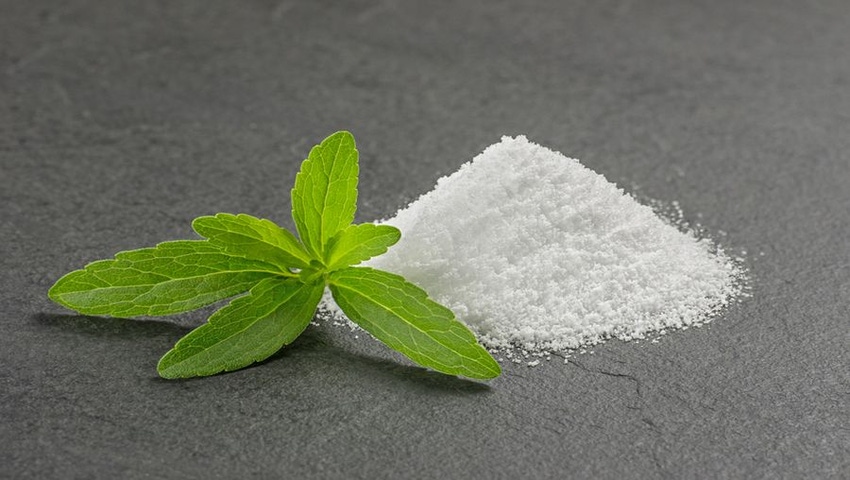Improvements in stevia sweeteners are opening new doors in the development of sugar-free and reduced-sugar beverages.
July 19, 2016

Today’s more health-conscious consumers aren’t as sweet on sugar-laden beverages as they once were. Growing concerns over added sugars are creating new opportunities for beverage innovation. As always, meeting consumer taste expectations is paramount for a successful product launch. The challenge for product developers is to create the most sugar-like experience possible in a reduced-sugar beverage.
It’s no easy task, but improvements in stevia sweeteners are opening new doors in beverage development. Scientists spent years unlocking the secrets of the stevia plant, identifying more than 40 different sweet components called steviol glycosides. Early stevia sweeteners relied on rebaudioside A (Reb A) for sweetness. While Reb A is plentiful in the stevia leaf, differences in sweetness dynamics and inherent aftertastes only allowed product developers to achieve relatively small reductions in sugar.
New stevia products have overcome many of these limitations, more closely mimicking the taste of sugar. The best of these use taste-prediction models to precisely determine the specific combinations of steviol glycosides that will deliver optimal taste and sweetness. These improvements in sweetness quality enable beverage manufacturers to achieve much deeper sugar reductions than were previously possible.
While sugar reduction is easier with these next-generation stevia sweeteners, it still requires a delicate balance between the science and art of product development. Sweetener components must be tailored to meet the needs of the specific beverage in development. The most successful reduced-sugar beverages are designed to optimize sweetness, replace the mouthfeel of sugar solids, and occasionally, manage minor aftertastes.
Optimizing Sweetness
Developing the next great, reduced-sugar beverage starts with an in-depth understanding of the many facets of sweetness. Each sweetener has its own distinct profile of immediate upfront sweetness, peak middle sweetness and latent sweetness. As a gold standard, sucrose has relatively quick onset with a high-quality, rounded middle sweetness and minimal lingering aftertaste. When reducing sugar, re-creating this experience is the key to meeting consumer taste expectations.
With this goal in mind, the first step in product development is deciding just how low to go. Today’s competitive marketplace demands the end product taste great. Beyond that, it must be compelling to label-conscious consumers. Some consumers are looking for reduced-sugar claims; others may be motivated by a specific label target such as less than 10 g of sugar per serving.
After defining the extent of sugar reduction, it is essential to build the product’s sweetness needs using a layered approach to product development. First, lay the foundation using stevia sweeteners. Cargill recommends targeting concentrations of stevia to deliver sweetness slightly below and above the sweetness gap. This bracketing approach helps gauge sweetness intensity and quality compared to a full-sugar beverage. It can also provide valuable insights on the relative effect on key flavor attributes, which are impacted by the complex balance between sweetness and sourness in beverages. Product developers can then rapidly explore additional concentrations between these bracketed ends by simply blending these stevia-sweetened beverages at different ratios, accelerating product development. Across the wide array of different beverages, it’s always surprising how seemingly slight shifts in the concentration of stevia sweeteners, just 10 parts-per-million, can have a dramatic impact on sweetness perception and flavor profile.
If needed, other sweeteners can be coupled with stevia products to help attain higher sweetness intensity, improve sweetness quality, and even optimize formulation costs for reduced-sugar beverages. In particular, erythritol is frequently used as a complementary sweetener to stevia. This calorie-free sugar alcohol helps round out the sweetness profile of stevia in beverages. Equally important, as a bulk sweetener, it can replace mouthfeel, which decreases with sugar reduction. Depending on the application, it may also be necessary to adjust levels of starches, hydrocolloids and other texturants to more closely replicate the body of a full-sugar beverage.
With the early Reb A stevia sweeteners, developers focused on managing aftertastes, such as bitterness, metallic or licorice notes. Given the huge leap forward in quality of sweetness, today’s next-generation stevia products give developers more versatility in their quest to create great-tasting, reduced-sugar beverages. However, in the final stage of development, especially with deeper sugar reductions, it may be necessary to leverage natural flavors, such as sweetness enhancers or modulators. These types of flavors can enhance upfront sweetness or round out the sweetness profile, delivering a closer dynamic to the full-sugar beverage.
Innovation Continues
Beverage brands’ ability to develop tasty reduced-sugar beverages has come a long way. Stevia was first approved for use in foods in 2008. In the ensuing years, we’ve seen a constant evolution in the quality of available stevia-based products. It is now possible to develop a great-tasting chocolate milk with no-added sugar or a 50-calorie carbonated soft drink with a 60- to 70-percent reduction in sugar.
Expect more improvements on the horizon, both in terms of the quality of stevia-based products and our understanding of optimum product development and formulations. Advances in fermentation technology will soon make it possible to offer affordable sweeteners based on the best-tasting glycosides in the stevia leaf, Reb M and Reb D. This next wave of sweeteners promises to bring us even closer to re-creating the sugar experience, making 100 percent sugar reduction possible.
Looking for more on key considerations in formulating beverages with functional ingredients? Join us for the Sparking Beverage Innovation workshop on Wednesday, Oct. 5, at SupplySide West 2016.
Wade Schmelzer is a principal food scientist for Cargill (cargill.com). Throughout his 16-year tenure at the company, he has focused on ingredient innovation and new product development for the health and wellness category. Most recently, he has been integrally involved in stevia sweetener development and its application across food and beverages. Schmelzer earned his master’s degree in food science from the University of Wisconsin-Madison.
About the Author(s)
You May Also Like




.png?width=800&auto=webp&quality=80&disable=upscale)